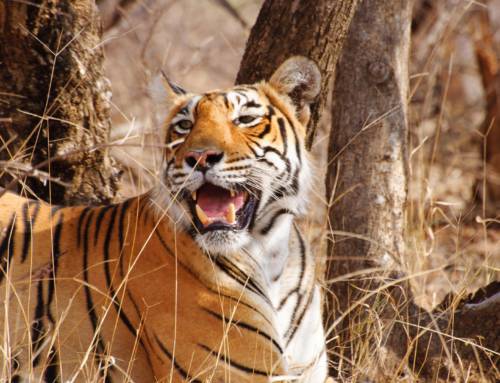Research Article: Puri, M., Srivathsa, A., Patel, I., Karanth, K. K., Kumar, N. S. (2023). Safe space in the woods: Mechanistic spatial models for predicting risks of human–bear conflicts in India. Biotropica.
Blog Author: Ishika Ramakrishna
Key takeaways:
- When people and large carnivores like the sloth bear interact, there could be negative consequences. If we could pre-emptively predict where incidents of conflict may occur, it would help mitigate negative human-wildlife interactions better.
- Situated in the forests spanning nearly 10,000 sq km between Kanha and Pench Tiger Reserves, the study looked at sloth bear distribution through direct ecological surveys, and also understood the patterns of their attacks on people over time through 675 household surveys.
- The team found that the amount of forest cover, terrain, the probability of sloth bear presence, and human disturbance in the landscape were among the crucial factors that determined the likelihood of human-bear conflict.
- Forests outside protected areas, with degraded habitats where people and wildlife co-occur, are commonplace in India. This study presents a valuable framework for better management of people’s interactions with large carnivores to ensure human safety, and the persistence of wild animals in shared spaces.
India is home to high population densities of people who live alongside a diversity of wildlife. With only about four percent of our terrestrial land under protection, a sizable proportion of our wildlife can be found outside of protected areas, and thus, in close proximity to human beings. This includes large mammals such as the elusive and intelligent sloth bear Melursus ursinus. In central India, human–sloth bear interactions are fairly common. This region houses two important habitats – the Kanha and Pench Tiger Reserves – which are home to a diversity of species. Some of these animals, including the sloth bear and other large carnivores, also make use of the corridor between these two reserves, a collective span of about 10,000 square kilometers.
When people and large carnivores overlap in a landscape, there is potential for negative interactions or consequences like human injury or death. While most studies in the past have focused on assessing these instances of conflict themselves, this particular study led by Dr. Mahi Puri and Dr. Arjun Srivathsa asked certain preventative questions instead:What if we could predict when and where these instances occur? Would it help mitigate negative human-wildlife interactions more effectively?
To answer these questions, the team set out to obtain information through two channels. First, they surveyed the expansive landscape for signs of sloth bears to understand how they are distributed across the area. Then, they interviewed 675 people from this region to obtain instances of sloth bear attacks on people, and the factors that resulted in those encounters. This data, coupled with information about the habitat, i.e., the kind of terrain, vegetation and seasonality, helped the scientists identify particular regions that were susceptible to human–bear conflict.
The research team found that the amount of forest cover, how rugged and uneven the terrain was, the probability of a sloth bear being present, and the amount of human disturbance in the landscape were among the crucial factors that could determine whether an area was susceptible to human-bear conflict. The team was able to create maps of central India that were indicative of these results, which could be used to pre-empt and prevent negative interactions between people and sloth bears.
Degraded forests like these in human-use areas are wide-spread in the country, and human-wildlife interactions in such spaces are common. By helping identify these hotspots of conflict and providing solutions for its mitigation, this study provides a valuable framework to ensure human safety, while also ensuring that important species like the sloth bear can continue to thrive in shared spaces. Hopefully, future research could also use these methods to reduce negative interactions and preserve positive relationships between people and other wild animals in this biodiverse country.
You can access the original article here.
Keywords: human–bear conflict, carnivores, conservation, predictive models, central India, sloth bears



